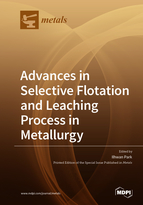Advances in Selective Flotation and Leaching Process in Metallurgy
A special issue of Metals (ISSN 2075-4701). This special issue belongs to the section "Extractive Metallurgy".
Deadline for manuscript submissions: closed (30 November 2021) | Viewed by 34933
Special Issue Editor
Interests: mineral processing; flotation; hydrometallurgy; leaching; electrochemistry; resource recycling; environmental remediation; acid mine drainage; sulfide passivation
Special Issues, Collections and Topics in MDPI journals
Special Issue Information
Dear Colleagues,
Metals are a finite resource, which is necessary to maintain living standards in modern society due to their countless applications like transportation vehicles, building and construction, household appliances, electronic devices, etc. In addition, the world is rapidly transitioning to “low-carbon technologies” using renewable energy sources (e.g., solar, wind, etc.) to combat climate change, and these technologies require vast amounts of metals per unit generation compared to that of conventional fossil generation; for example, 11–40 times more copper (Cu) for solar photovoltaic (PV) systems and 6–14 times more iron (Fe) for wind power stations.
Unfortunately, easily exploitable ore deposits are hard to find, which makes it unavoidable that mining industries must develop complicated ore deposits with low-grade and fine grain-size. The complexity of these ore bodies requires fine grinding to achieve the appropriate liberation of valuable minerals. Typically, there are two scenarios to extract metals from finely-ground ores; that is, (1) concentration of valuable minerals via “flotation” followed by smelting process and (2) direct extraction of metals from finely-ground ores by “leaching” followed by purification and recovery processes (e.g., solvent extraction and electrowinning; SX-EW). Therefore, flotation and leaching, both of which are the first stage of each scenario, of finely-ground ores are of crucial importance to assure the continued supply of metals.
This Special Issue will be devoted to collecting papers on recent advances in selective flotation and leaching processes for any metal-containing ores. It is my pleasure to invite you to contribute to this Special Issue, and your valuable contribution will make this Special Issue successful. Both original research papers and reviews are all welcome. The topics of interest include, but are not limited to, selective flotation, selective depression, fine particle flotation, bioflotation, atmospheric leaching, pressure leaching, bioleaching, mineral processing, and hydrometallurgy.
Dr. Ilhwan Park
Guest Editor
Manuscript Submission Information
Manuscripts should be submitted online at www.mdpi.com by registering and logging in to this website. Once you are registered, click here to go to the submission form. Manuscripts can be submitted until the deadline. All submissions that pass pre-check are peer-reviewed. Accepted papers will be published continuously in the journal (as soon as accepted) and will be listed together on the special issue website. Research articles, review articles as well as short communications are invited. For planned papers, a title and short abstract (about 100 words) can be sent to the Editorial Office for announcement on this website.
Submitted manuscripts should not have been published previously, nor be under consideration for publication elsewhere (except conference proceedings papers). All manuscripts are thoroughly refereed through a single-blind peer-review process. A guide for authors and other relevant information for submission of manuscripts is available on the Instructions for Authors page. Metals is an international peer-reviewed open access monthly journal published by MDPI.
Please visit the Instructions for Authors page before submitting a manuscript. The Article Processing Charge (APC) for publication in this open access journal is 2600 CHF (Swiss Francs). Submitted papers should be well formatted and use good English. Authors may use MDPI's English editing service prior to publication or during author revisions.
Keywords
- selective flotation
- selective depression
- fine particle flotation
- bioflotation
- atmospheric leaching
- pressure leaching
- bioleaching
- mineral processing
- hydrometallurgy






